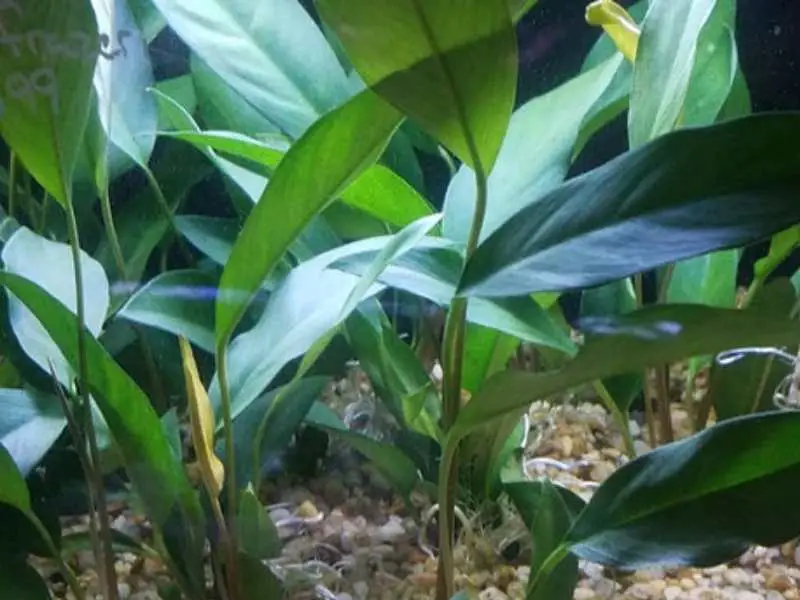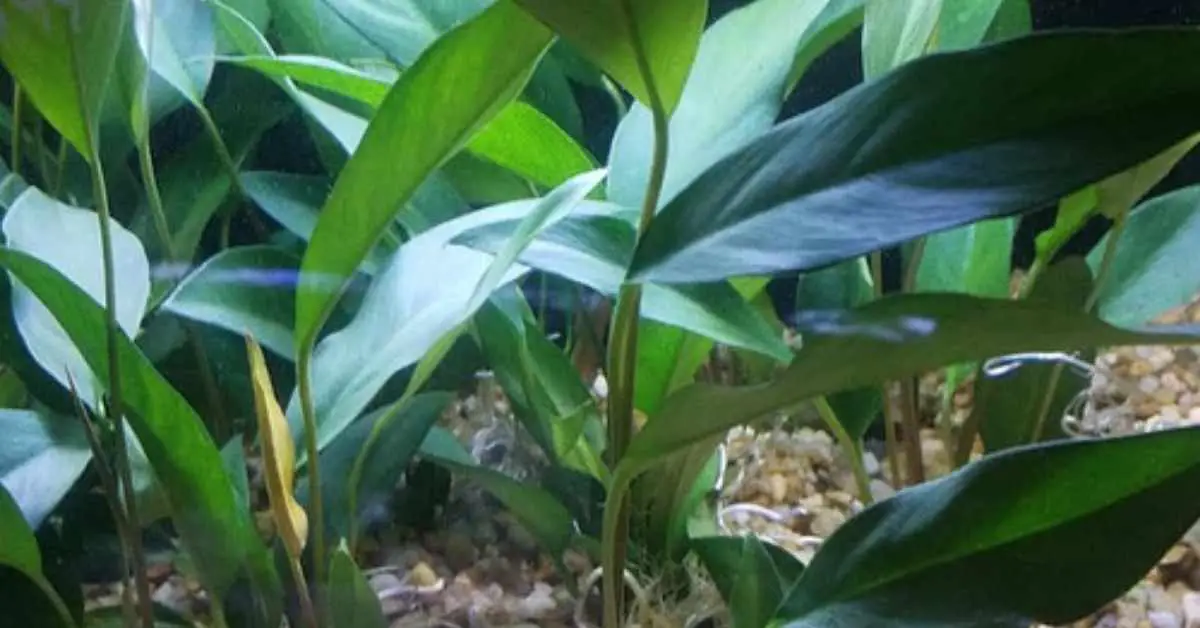Anubias afzelii is a beautiful aquarium plant that is native to Africa where it grows in slow-moving or still water bodies including ponds, ditches, and streams. Heinrich Wilhelm Schott first recoded and described this plant in 1857. It is a slow-growing plant, so it is perfect for small aquariums. It does not require much light or fertilizer, making it easy to care for. It can be used in both freshwater and saltwater aquariums. Anubias afzelii grows slowly and should not be moved often once it has become established. This plant does best when attached to a hard surface such as a rock or driftwood, but can also be grown in substrate if anchored securely.
Systematic Position
Kingdom: Plantae
Clade: Angiosperm
Order: Alismatales
Family: Araceae
Genus: Anubias
Species: Anubias afzelii
Physical Appearance
Anubias Afzelii is a beautiful and unique plant that has many distinguishing features. This perennial herb produces an upright stalk up to 1 meter (3 feet) tall from a creeping rhizome. It has broad, and ovate dark green leaves with a short petiole and an acute apex that are about 8-12 inches long. The leaf margins have small spines, and the veins are light green and prominently visible on the underside of the leaves. In addition to its attractive foliage, Anubias Afzelii also produces small, white flowers near the top of its stem that rise above the water surface in late spring or early summer. Each flower has 3 sepals and 3 petals; the petals are white or yellow with purple spots near the base.

Origin
Anubias afzelii is native to Africa.
Anubias afzelii size
It can grow up to 1 meter (3 feet) in height and 5 inches in wide.
Aquarium size
The minimum recommended aquarium size should be 10 gallons to keep this plant.
Anubias afzelii Quick Facts
Scientific name: Anubias afzelii
Origin: Africa
Height: 1 meter (3 feet)
Growth form: Stem
Growth rate: Slow
Minimum tank size: 10 gallons
Ideal Tank Placement: Background
Propagation: Cutting the Rhizome
Water pH: 6.0-7.5
Water Temperature: 68 and 86 degrees Fahrenheit
Hardness: 7-15 dGH
CO2 Requirement: Not needed – Low
Recommended substrate: Fine gravel
Recommended lighting: Medium
Care Level: Easy
Housing and Care Facts
Anubias Afzelii is a hardy, aquatic plant that can be used in both fresh and salt water aquariums. It grows slowly, but it does not require much light or fertilizer, making it an ideal choice for beginning aquarists. It is also known for its ability to reduce algae growth in the tank. It is ideal for small tanks or those just starting out with plants. Anubias afzelii is also one of the few plants that can survive being submerged under water for extended periods of time without dying off.
Tankmates
It is an ideal plant for beginners and it can be grown attached to rocks or driftwood, and it makes a great addition to any tank. When choosing tankmates for an aquarium with Anubias afzelii, it is important to consider the size of the fish and their temperament. Smaller fish that are peaceful will do well with Anubias afzelii, but larger aggressive fish should be avoided. Some good choices include guppies, tetras, and danios.
Light Requirement
This plant does not require much light, making it a good choice for beginners. Anubias afzelii will thrive in low-light conditions or even under direct sunlight. It prefers temperatures of 68-86 degrees Fahrenheit and a pH of 6.0-7.5.
Substrate/Soil Requirements
It does not like root competition, so it should only be planted in areas where there are no other plants growing nearby. When planting Anubias afzelii, use a soil mix that is high in organic matter and has good water retention properties and has plenty of nutrients. A good option for substrates with these properties is black cotton soil, which can be found at most garden stores. Another option would be to mix some peat moss into your regular aquarium substrate to create a more nutrient-rich environment for your Anubias afzelii plants.
Fertilizer Requirement
This species does not require much fertilizer, making it an ideal choice for those new to planted tanks. In fact, too much fertilizer can be harmful to Anubias afzelii and other plants in the tank. It will benefit from regular fertilization with a balanced liquid fertilizer such as Seachem Flourish or API Leaf Zone. A simple once a week liquid or tablet fertilizer will provide all the nutrients this plant needs. Fertilizing your Anubias afzelii every two weeks should be sufficient to maintain healthy growth. This plant does best in nutrient-rich water with a pH of 6.5 to 7.5, but can tolerate a pH as low as 5.0 and as high as 8.5.
Temperature
Anubias afzelii does well in wide range of water temperatures, making it an ideal choice for the home aquarium. This plant does best in temperatures between 68 and 86 degrees Fahrenheit, with a pH range of 6.5 to 7.5.
Pruning
The plant can grow quite large, so it is often necessary to prune it back occasionally. Pruning should be done with care, as the leaves and roots are fragile. The best time to prune Anubias afzelii is when the plant is in its active growth phase, which usually occurs in spring or summer. Use sharp scissors or clippers to cut away any dead or damaged leaves and stems. You can also trim back any overly long branches to keep the plant tidy. Be sure not to cut into the rhizome, as this will damage or kill the plant.
Growth Rate
Anubias afzelii is a slow growing aquatic plant that requires little maintenance and can be grown in a variety of water conditions. Its growth rate is slow, but it can eventually reach a height of 24 inches. Anubias afzelii will grow best when attached to a hard surface such as driftwood or rocks, but can also be grown in soil if the pot is large enough. This plant does not require frequent fertilization and only needs moderate water changes.
Pest and Diseases
Anubias afzelii is susceptible to a number of pests and diseases, including algae, snails, and fungus. The most common pest affecting Anubias afzelii is the anacharis leaf beetle. These small black beetles can cause significant damage to the leaves of the plant, leading to reduced growth or even death. If you notice any signs of beetle damage on your Anubias plants, remove them from the aquarium immediately and treat with an appropriate insecticide.
Another potential pest for Anubias afzelii is algae. Algae can be difficult to get rid of once it takes hold in an aquarium, and it can quickly cover the leaves of this sensitive plant. To prevent algae from becoming a problem, keep your tank clean and well-lit, and avoid overfeeding your fish. Algae can also be controlled by regularly removing any excess vegetation from the tank and by adding an algaecide to the water.
Snails can also cause damage of your plants. It can be eliminated with traps or by introducing predators such as fish or shrimp into the tank.
Anubias afzelii is also susceptible to root rot, fungal infection, and bacterial infection.
Root rot is another most common disease affecting Anubias afzelii. The roots will turn black and decay, which will cause the plant to die. To prevent root rot, make sure the soil in your aquarium is well-drained and do not over-water your plants.
Fungal infection can also affect Anubias afzelii. The leaves of the plant will start to turn brown or black and will eventually fall off. Fungal infections are often caused by too much light or heat exposure in an aquarium setting. To treat a fungal infection, remove any infected leaves from the plant and treat with a fungicide or removed from the plant manually.
Bacterial infections are also possible in Anubias afzelii plants. Signs of bacterial infection include wilting leaves, yellowing leaves , brown patches on the leaves ,and slimy growth on stems or roots . Bacterial infections can be treated with antibiotics if caught early enough.
Propagation
Anubias afzelii can propagate by dividing the rhizomes easily. The rhizomes (underground stems) of this plant can be cut into small pieces and planted in the substrate. The best time to propagate Anubias afzelii is when the plant is growing new leaves. To propagate Anubias afzelii, cut off a section of the rhizome with at least two leaves attached and replant in fresh water. New plants will grow from the cut rhizomes, and they will eventually form new colonies. Anubias afzelii can also be propagated by dividing older colonies of plants.
Concluding Remarks
Anubias afzelii is a species of aquatic plant that is found in Africa. It can be used for aquariums and ponds, and it has a variety of uses. Anubias afzelii can grow in a number of different water conditions, making it an ideal plant for both new and experienced aquarists. It also helps to reduce algae growth in the tank or pond, making it a valuable addition to any aquatic ecosystem.

